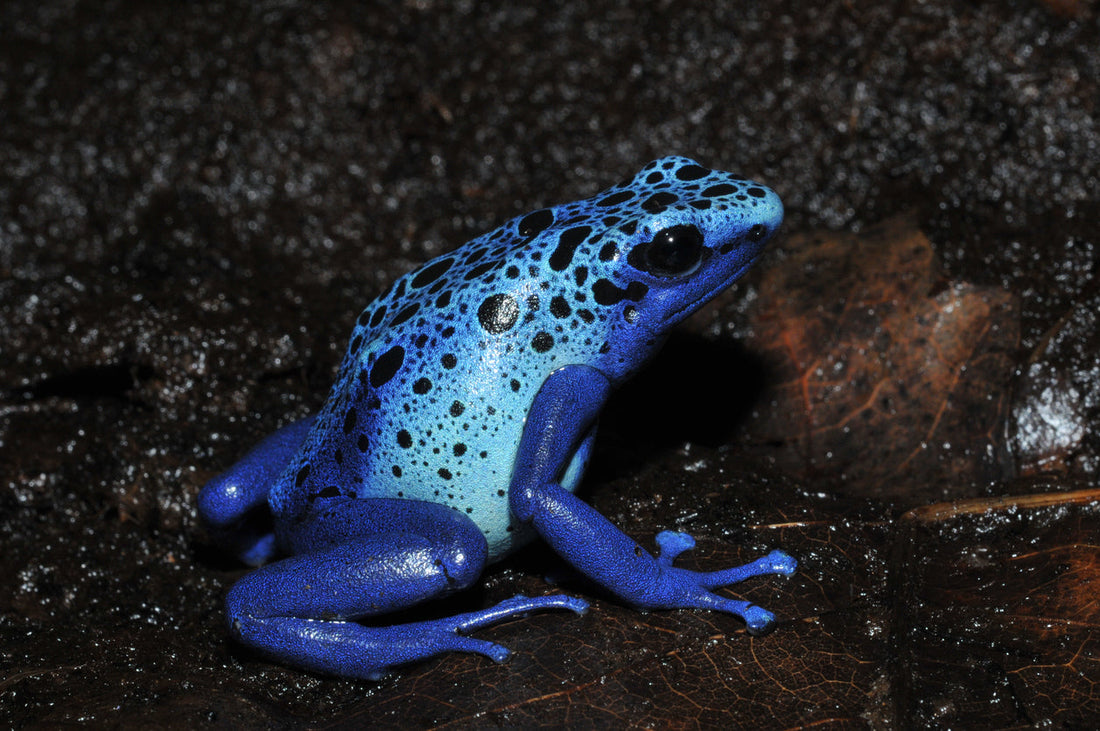Poison Dart Frog (Dendrobatidae species) Care Sheet
Quick Facts
Scientific Name: Dendrobatidae (various species, e.g., Dendrobates auratus, Oophaga pumilio)
Common Names: Poison Dart Frog, Dart Frog
Origin: Central and South America
Adult Size: 2–5 cm (0.8–2 inches), species dependent
Lifespan: 5–10 years in captivity, some species living up to 15 years
Sex Differences: Females are generally larger and more robust; males are slightly smaller and slimmer, often more vocal
Beginner Suitability: Moderate – small, colourful frogs with specific temperature, humidity, and dietary needs
Enclosure
Size: A pair or small group can be housed in a 30 cm x 30 cm x 30 cm (12 x 12 x 12 inches) vivarium. Larger, vertically oriented terrariums are preferred for climbing and enrichment.
Substrate: Use moisture-retaining substrates such as coco fibre, sphagnum moss, or a bioactive soil mix. Avoid substrates that can cause impaction or mould growth.
Hides: Provide multiple hiding spots using plants, cork bark, or leaf litter. Include climbing surfaces like branches and artificial vines.
Heating: Maintain a daytime temperature of 22–26°C and a night temperature of 18–22°C. Avoid direct heat sources that can dry out the enclosure.
Lighting: Provide a 12-hour light / 12-hour dark cycle. Low-level UVB (2–5%) is optional but can promote health and natural behaviour.
Humidity: Maintain 70–90% humidity. Mist daily or use an automated misting system. Ensure good ventilation to prevent stagnant air and mould.
Diet
Primary Diet Type: Insectivore
Food Items: Feed small live invertebrates such as fruit flies (Drosophila), pinhead crickets, springtails, and small isopods. Hatchlings require tiny prey, while adults can take larger insects.
Feeding Frequency: Feed daily or every other day depending on prey availability and appetite. Remove uneaten insects to prevent stress or competition.
Feeding Troubleshooting: Ensure prey is appropriately sized and gut-loaded when possible. Provide calcium and vitamin supplements by dusting prey regularly. Monitor feeding behaviour closely, as smaller frogs may require separate feeding areas.
Water
Provide shallow, clean water dishes or maintain water in plants and substrate. Frogs absorb moisture through their skin, so high humidity is critical. Avoid standing water that could stagnate.
Behavior And Handling
Poison Dart Frogs are delicate and should generally not be handled. Handling can stress the frogs and risk transferring oils or chemicals from skin to frog. Use tools like tweezers for feeding and maintenance.
Enrichment
Include live plants, leaf litter, cork bark, and branches for climbing. Maintain a bioactive setup with microfauna such as springtails and isopods to assist with waste management.
Health
Signs of illness include lethargy, weight loss, abnormal skin coloration, fungal infections, or failure to eat. Maintain proper humidity, temperature, and hygiene. Consult an amphibian-specialist veterinarian if needed.
Lifespan
Typically 5–10 years in captivity, with some species living up to 15 years under excellent care.
Legality In The UK
Poison Dart Frogs are legal to keep in the UK. No licence is required for private ownership, but species must be captive-bred. Owners must comply with Welfare of Animals regulations.
Difficulty Bars (Relative)
| Category | Level |
|---|---|
| Feeding | ████▁ Moderate (requires small live invertebrates and supplementation) |
| Handling | █▁▁▁▁ Very Low (fragile species, minimal handling) |
| Humidity Needs | █████ High (70–90% required) |
| Enclosure Setup | ████▁ Moderate (bioactive setup and climbing spaces essential) |
| Beginner Suitability | ███▁▁ Moderate (suitable for attentive, experienced beginners) |

